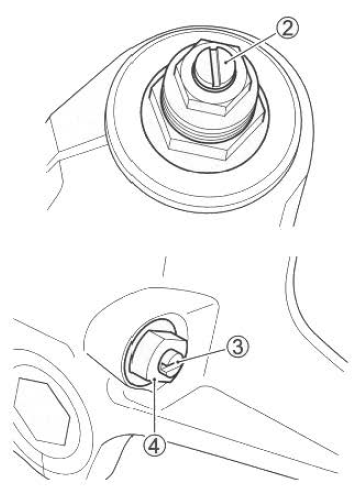Suzuki GSX-R 1000 Owners Manual: Damping force adjustment
The rebound and compression damping force can be individually adjusted by turning the respective adjusters. The rebound damping force adjuster 2 is located at the top of the front fork. The compression damping force adjuster 3 is located at the bottom of the front fork.

To adjust the damping force, set the adjuster to the standard setting first and then adjust the adjuster to the desired position.
To set the rebound and compression damping force, turn the adjuster clockwise until it stops and then turn it counterclockwise.
As you turn the adjuster, you will notice clicks. Count the number of clicks from fully turned-in position.
The standard rebound damping force setting is 9 clicks. The standard compression damping force setting is 14 clicks.
Turn the adjuster clockwise from the standard position to stiffen the damping force. Turn the adjuster counterclockwise to soften the damping force. The damping force should be adjusted gradually, 1/4 turn at a time, to fine-tune the suspension.
Note
: do not loosen the adjuster base 4, or front fork oil will ooze through the adjuster base.
 Warning Warning
Adjust the right and left front forks to the same settings. |
 Spring pre-load adjustment
Spring pre-load adjustment
To change the spring pre-load,
turn the adjuster 1 clockwise or
counterclockwise. Turning the
adjuster clockwise will increase
the spring pre-load. Turning the
adjuster counterclockwise will
...
 Rear suspension
Rear suspension
...
Other materials:
Front wheel assembly removal and installation
Removal
Remove the brake calipers, left and right.
Caution
do not operate the brake lever with the
caliper removed.
Loosen two axle pinch bolts (1) on the right front fork
leg.
Remove the front axle bolt (2).
Raise the front wheel off the ground a ...
Fuel pump inspection
Turn the ignition switch on and check that the fuel pump
operates for a few seconds.
If the fuel pump motor does not make operating sound, inspect the fuel pump
circuit connections or inspect the fuel pump relay and to sensor. Refer to “fuel
pump relay inspection” and “dtc “c23” (p1651 ...
Electrical parts connector / coupler
Faulty fi system is often related to poor electrical
contact of connector/coupler. Before servicing
individual electronic part, check electrical contact of
the connector/coupler.
When connecting a connector, be sure to push it in
until a click is felt.
With a lock type coupler ...
